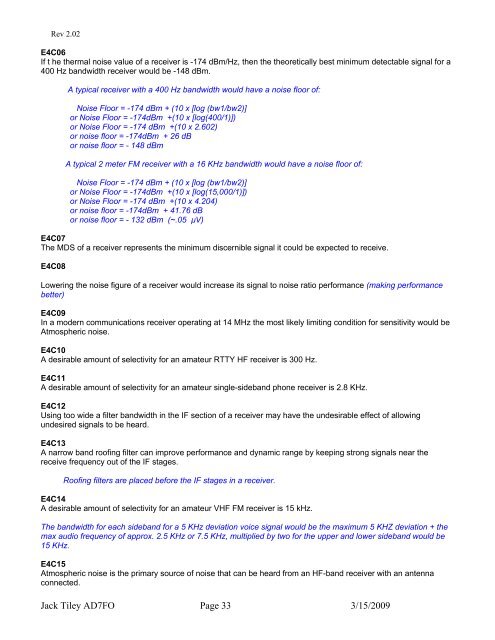Create successful ePaper yourself
Turn your PDF publications into a flip-book with our unique Google optimized e-Paper software.
Rev 2.02<br />
E4C06<br />
If t he thermal noise value of a receiver is -174 dBm/Hz, then the theoretically best minimum detectable signal for a<br />
400 Hz bandwidth receiver would be -148 dBm.<br />
A typical receiver with a 400 Hz bandwidth would have a noise floor of:<br />
Noise Floor = -174 dBm + (10 x [log (bw1/bw2)]<br />
or Noise Floor = -174dBm +(10 x [log(400/1)])<br />
or Noise Floor = -174 dBm +(10 x 2.602)<br />
or noise floor = -174dBm + 26 dB<br />
or noise floor = - 148 dBm<br />
A typical 2 meter FM receiver with a 16 KHz bandwidth would have a noise floor of:<br />
Noise Floor = -174 dBm + (10 x [log (bw1/bw2)]<br />
or Noise Floor = -174dBm +(10 x [log(15,000/1)])<br />
or Noise Floor = -174 dBm +(10 x 4.204)<br />
or noise floor = -174dBm + 41.76 dB<br />
or noise floor = - 132 dBm (~.05 µV)<br />
E4C07<br />
The MDS of a receiver represents the minimum discernible signal it could be expected to receive.<br />
E4C08<br />
Lowering the noise figure of a receiver would increase its signal to noise ratio performance (making performance<br />
better)<br />
E4C09<br />
In a modern communications receiver operating at 14 MHz the most likely limiting condition for sensitivity would be<br />
Atmospheric noise.<br />
E4C10<br />
A desirable amount of selectivity for an amateur RTTY HF receiver is 300 Hz.<br />
E4C11<br />
A desirable amount of selectivity for an amateur single-sideband phone receiver is 2.8 KHz.<br />
E4C12<br />
Using too wide a filter bandwidth in the IF section of a receiver may have the undesirable effect of allowing<br />
undesired signals to be heard.<br />
E4C13<br />
A narrow band roofing filter can improve performance and dynamic range by keeping strong signals near the<br />
receive frequency out of the IF stages.<br />
Roofing filters are placed before the IF stages in a receiver.<br />
E4C14<br />
A desirable amount of selectivity for an amateur VHF FM receiver is 15 kHz.<br />
The bandwidth for each sideband for a 5 KHz deviation voice signal would be the maximum 5 KHZ deviation + the<br />
max audio frequency of approx. 2.5 KHz or 7.5 KHz, multiplied by two for the upper and lower sideband would be<br />
15 KHz.<br />
E4C15<br />
Atmospheric noise is the primary source of noise that can be heard from an HF-band receiver with an antenna<br />
connected.<br />
Jack Tiley <strong>AD7FO</strong> Page 33 3/15/2009


